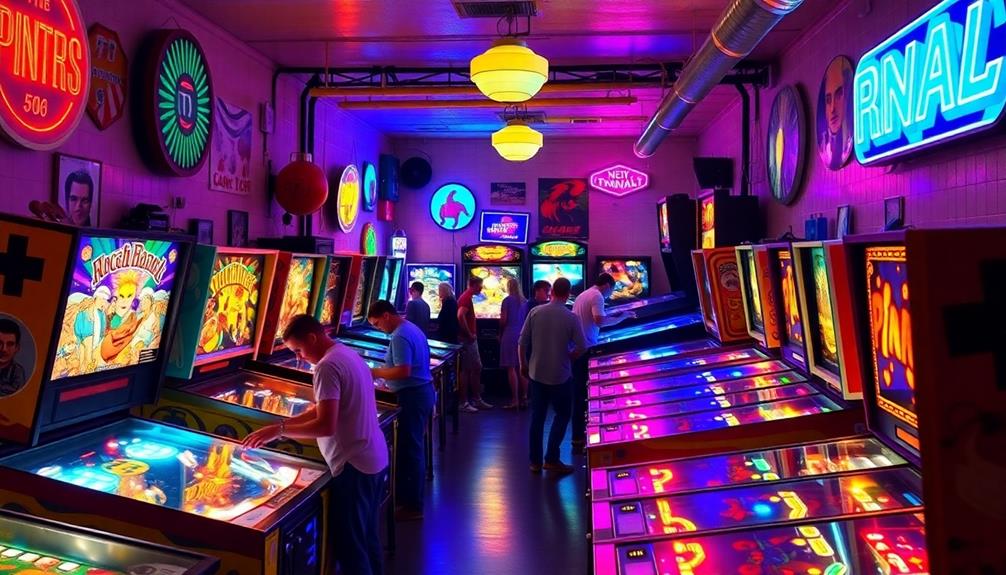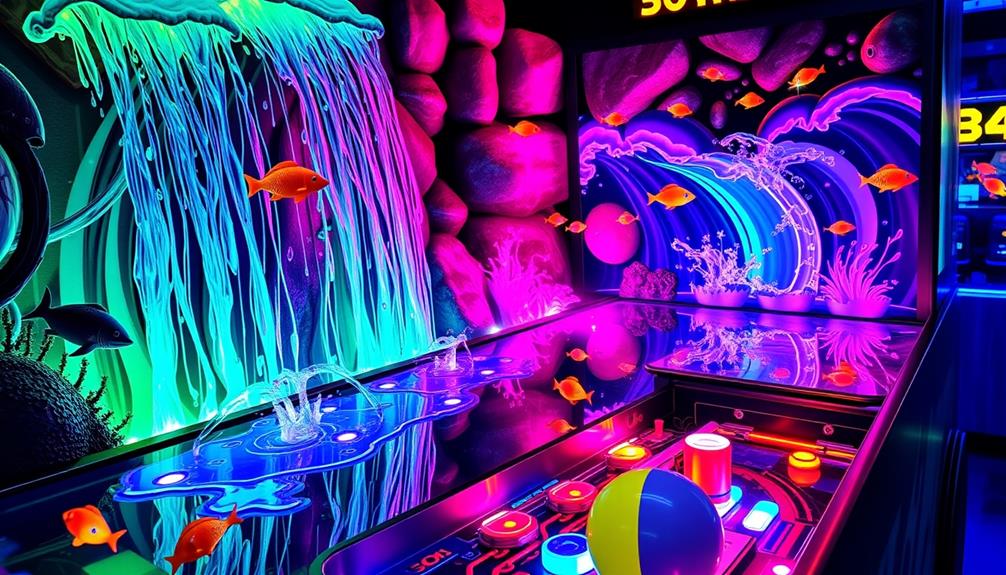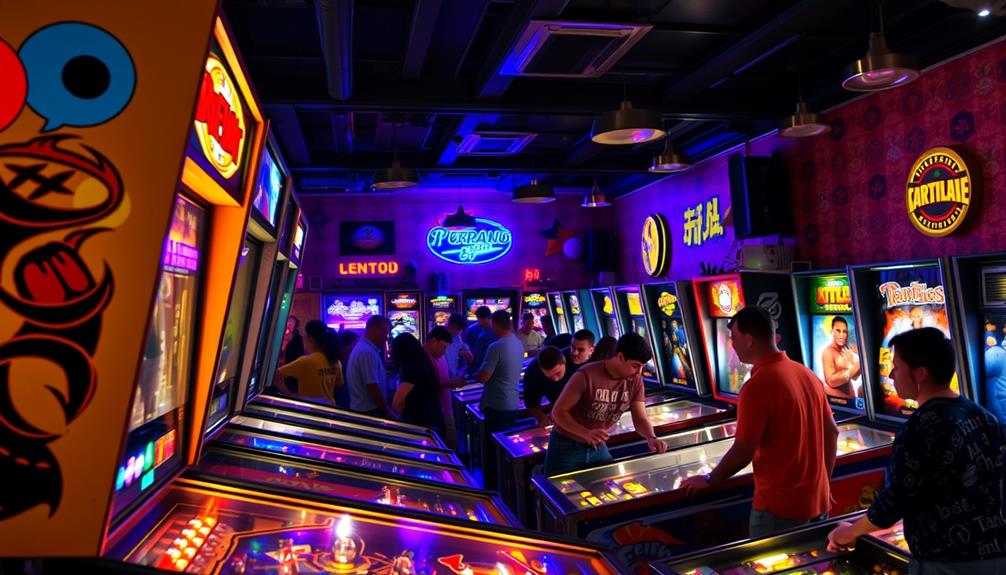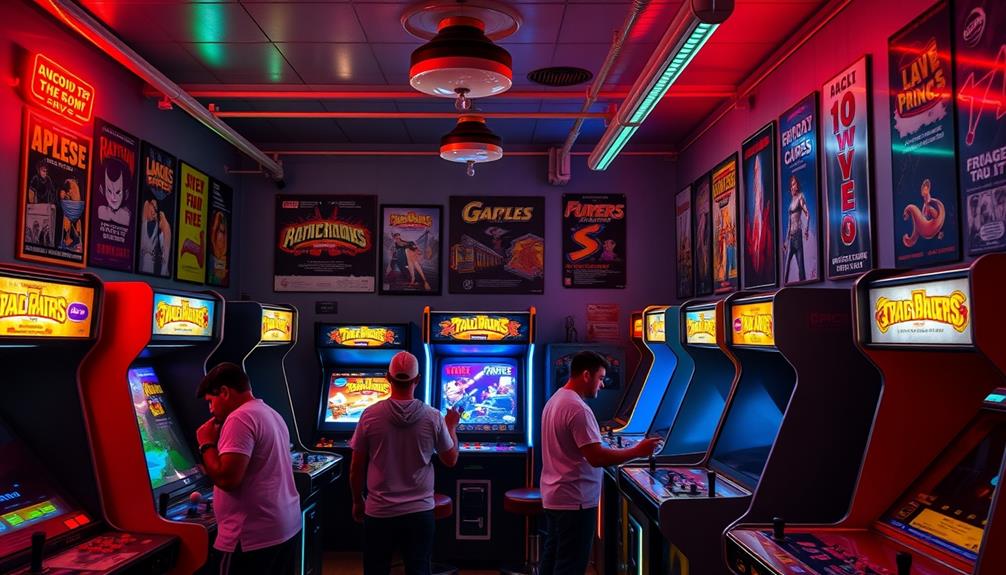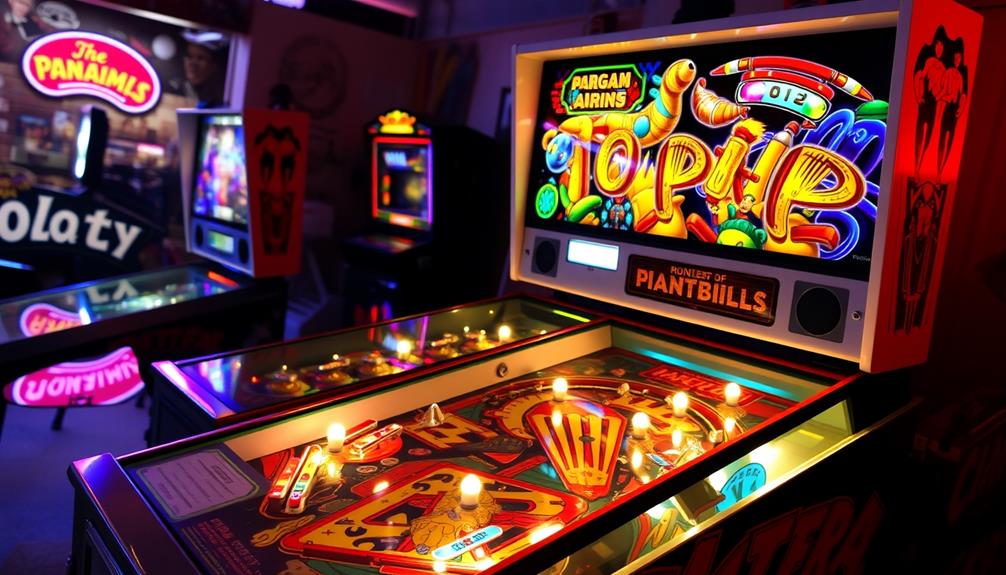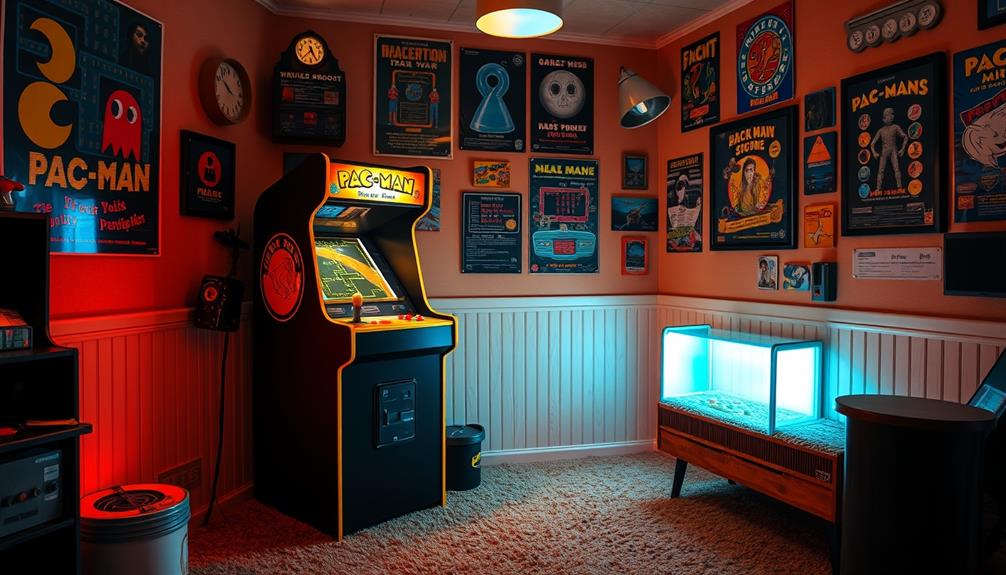Pinball machines gained popularity in the 1930s, transitioning from being rare novelties to common features in bars and arcades. Coin-operated models like Bally’s Ballyhoo and Gottlieb’s Baffle Ball captured players’ interests with vibrant artwork and electric scoring, making them more attractive. By 1940, approximately 15,000 machines were in use throughout the U.S., solidifying pinball’s presence in entertainment culture. This golden era continued into the 1970s, thanks to advancements such as flippers and intricate scoring. If you’re interested in learning more about how pinball evolved and overcame challenges, there is a wealth of information to explore regarding its rich history and current resurgence.
Key Takeaways
- Pinball machines gained popularity during the 1930s as coin-operated models became widely accessible in bars and arcades across America.
- Bally's Ballyhoo, launched in 1931, was among the first successful coin-operated machines that captivated players and solidified pinball's cultural presence.
- The introduction of flippers in 1947 revolutionized gameplay, enhancing player control and attracting a larger audience during the Golden Age of Pinball.
- By 1945, around 15,000 pinball machines were operational in the U.S., establishing pinball as a staple entertainment option.
- Peak sales of pinball machines reached 200,000 by 1979, marking the height of its popularity before the rise of video games.
Early Origins of Pinball
The early origins of pinball can be traced back to the bagatelle tables of the early 19th century, where players rolled balls into pockets to score points. These tables laid the groundwork for what would evolve into pinball machines.
In 1871, Montague Redgrave patented an improved version of bagatelle, introducing a coiled spring and plunger mechanism that greatly changed gameplay. This innovation set the stage for modern pinball machines, allowing for greater control and precision.
Additionally, the evolution of pinball gameplay has led to the creation of some of the best rated pinball machines of 2024, showcasing advanced technology and design that enhance player experiences. That same year, Gottlieb Daimler patented the first true pinball machine, which featured a rotating playfield. This marked a pivotal moment in pinball history, as it combined elements of bagatelle with new mechanics, making the game more dynamic and engaging.
As the years rolled on, the concept of pinball continued to develop, capturing the interest of players everywhere. While widespread popularity wouldn't emerge until the 1930s, the groundwork laid in the 19th century was essential in shaping the beloved game we understand today.
From bagatelle's simple beginnings, pinball transformed into an iconic part of gaming culture.
Rise in Popularity During the 1930s
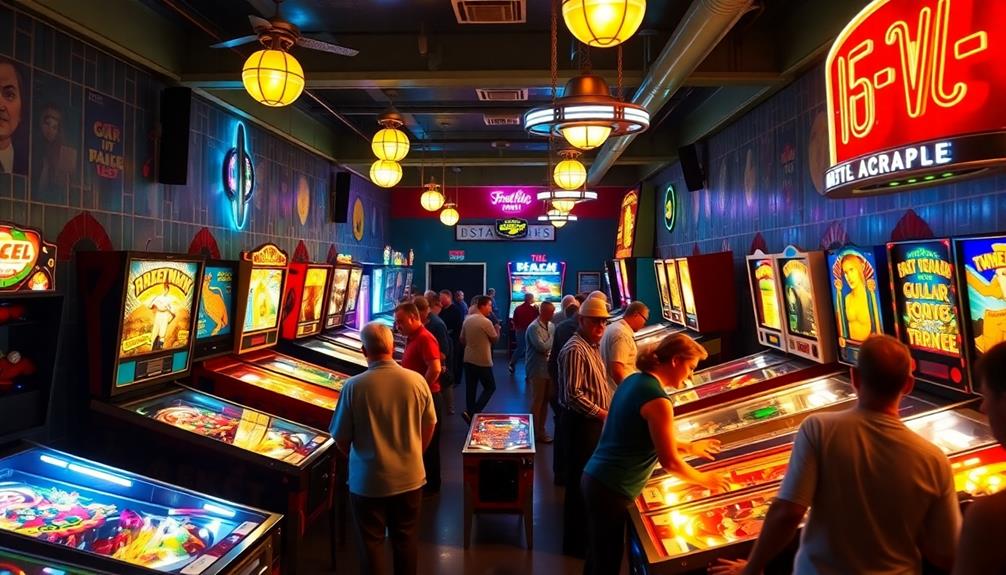
In the 1930s, you'd notice a boom in coin-operated pinball machines across America, transforming entertainment venues everywhere.
The integration of modern technology into these machines, such as electric scoring and vibrant artwork, captured the attention of a growing audience. As cultural shifts took hold, people sought new forms of amusement, and pinball quickly became a favorite pastime.
With major manufacturers entering the scene, the competition only fueled its rising popularity, making it a staple in bars, candy stores, and arcades.
Best arcade machines were highlighted for their user-friendly features, further solidifying pinball's status in the entertainment landscape.
Coin-Operated Machine Boom
During the 1930s, pinball machines skyrocketed in popularity across the United States, thanks to the rise of coin-operated models that made the game more accessible than ever. The introduction of the coin-operated pinball machine allowed people to enjoy the game without the need for prior experience or significant investment. Bally Manufacturing played a significant role in this boom, releasing Ballyhoo in 1931, one of the first successful coin-operated machines.
The popularity of pinball continued to grow with games like Gottlieb's Baffle Ball, which drove manufacturers to produce thousands of machines to meet increasing demand. By mid-1930s, the term "pinball" was officially coined, solidifying its place in the arcade landscape.
Here's a quick look at some key milestones in the rise of pinball during this era:
| Year | Event | Impact on Popularity |
|---|---|---|
| 1931 | Ballyhoo released | First successful coin-operated model |
| 1935 | "Pinball" term officially coined | Solidified the game's identity |
| 1935 | Gottlieb's Baffle Ball released | Increased public interest |
| 1940 | 15,000 machines operational | Established pinball as a staple |
| 1945 | Widespread presence in bars and arcades | Mainstream acceptance |
Cultural Shifts in Entertainment
Amid the economic struggles of the Great Depression, pinball machines emerged as a vibrant escape, offering affordable entertainment to a diverse audience. You can imagine the allure of a simple game that provided a momentary distraction from daily hardships.
The release of Ballyhoo in 1931 marked a pivotal moment in the popularity of pinball machines, enchanting players and solidifying their place in American culture. This period also saw the introduction of mechanical components that enhanced gameplay, making pinball more engaging and interactive.
By the mid-1930s, the term "pinball" was officially coined, reflecting the game's growing identity. You'd see these machines popping up in bars and candy stores, becoming a staple of social venues.
The introduction of coin-operated machines further increased their accessibility, allowing more people to engage and enjoy the game. As pinball machines gained popularity, they transformed entertainment culture, offering a communal experience that brought people together during tough times.
Golden Age of Pinball

The Golden Age of Pinball, spanning from the early 1930s to the early 1970s, transformed the gaming landscape with the rise of coin-operated machines that captivated players across the United States. One of the early hits, Ballyhoo, introduced by Bally Manufacturing Corporation in 1931, sparked widespread interest, with over 15,000 machines operational in the U.S. by the 1950s.
The introduction of flippers in 1947, particularly with Humpty Dumpty, revolutionized gameplay by allowing players to actively control the ball, enhancing engagement and fun. By the 1960s, machines featured advanced electromechanical systems, lights, and intricate scoring mechanisms, solidifying their status as entertainment staples.
Here's a quick overview of key milestones during the Golden Age:
| Year | Milestone |
|---|---|
| 1931 | Ballyhoo launched |
| 1947 | Flippers introduced |
| 1960s | Advanced electromechanical systems |
| 1979 | Peak sales of 200,000 machines |
Decline in the Late 20th Century

As you look back at the late 20th century, you'll notice pinball machines started to lose their appeal as video games took center stage in arcades.
The shift towards more immersive digital experiences marked a growing trend in entertainment preferences, paralleling the rise of AI Cybersecurity Jobs that focus on protecting digital assets.
New regulations made it tougher for manufacturers, and many venues shifted their focus to digital gaming for higher profits.
This cultural transformation marked a significant turning point, leading to a sharp decline in the presence and sales of pinball machines.
Impact of Video Games
Witnessing the rise of arcade video games in the late 20th century, many pinball enthusiasts found themselves drawn to the more interactive and immersive experiences these digital games offered.
As iconic titles like Pac-Man and Space Invaders emerged, the pinball industry began to suffer. Gamers shifted their focus, leaving pinball machines as a relic of the past. The integration of AI technologies in gaming further enhanced player engagement, making traditional pinball less appealing.
By the early 1980s, this shift in consumer preference was evident, with sales of pinball machines plummeting dramatically. Following the video game crash of 1983, the decline reached an estimated 85%, as manufacturers struggled to compete with the allure of digital gaming.
You might've noticed that many arcades started favoring video game cabinets, leading to a significant reduction in the number of operational pinball machines.
As the 1990s rolled in, only a few hundred pinball machines remained in the U.S., as establishments phased them out entirely. The cultural embrace of digital gaming further eroded pinball's standing, culminating in the closure of major manufacturers like Gottlieb and Capcom.
This marked a significant downturn in pinball's presence in the arcade landscape, reshaping the gaming experience for generations to come.
Regulatory Challenges Faced
While pinball machines once thrived in arcades, a wave of regulatory challenges emerged by the late 1970s and early 1980s, complicating their manufacturing and operation.
Many cities imposed bans on pinball machines, linking them to gambling activities, which created a negative perception that impacted their appeal. This perception led to a significant reduction in their availability in public venues, making it harder for you to find a place to enjoy your favorite game.
As these regulations took hold, you likely noticed a decline in pinball's popularity. Establishments began phasing out pinball machines, opting instead for the rising allure of video games.
This shift not only reflected changing consumer preferences but also made it clear that pinball was struggling to keep pace with the new gaming landscape.
Additionally, this decline in availability can be likened to the importance of maintaining a budget and managing expenses, as unexpected changes can impact what was once a thriving source of entertainment budget management.
Cultural Shift to Digital
The decline of pinball machines in the late 20th century coincided with the rapid rise of arcade video games, which captivated audiences and shifted consumer preferences toward digital experiences. As you might recall, the late 1970s and early 1980s marked a turning point; arcade games became the main attractions in entertainment venues, overshadowing pinball machines.
This shift in consumer behavior can be likened to the evolving landscape of free crypto opportunities, where new trends often capture public interest. By the early 1990s, only a few hundred pinball machines remained operational in the U.S., a stark contrast to the approximately 15,000 machines during the 1950s.
This decline in popularity was exacerbated by new laws and regulations that made manufacturing and operating pinball machines increasingly challenging. As establishments looked to maximize profit, they phased out pinball in favor of more lucrative digital gaming options.
The cultural shift toward home consoles and digital gaming further marginalized pinball, pushing it to the sidelines. By the mid-1990s, prominent pinball manufacturers like Gottlieb and Capcom shut down operations, highlighting how the overwhelming dominance of video games led to a significant downturn in the pinball industry.
Ultimately, this cultural change transformed the landscape of gaming, leaving pinball machines to grapple with their diminished status.
Technological Innovations in Pinball
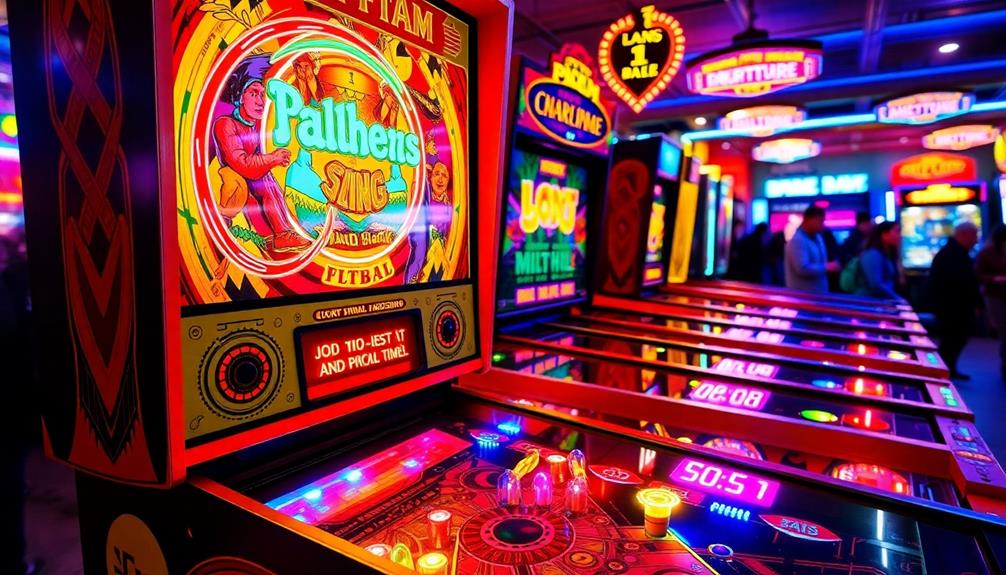
How have technological innovations transformed the world of pinball? These advancements haven't only enhanced gameplay but also expanded its appeal to a wider audience. From the early days of mechanical machines to today's sophisticated designs, here's how pinball has evolved:
- The first electrically powered machine in 1933 introduced sound effects and lights for better player engagement, similar to the way Blue Skies and Lemonade evokes feelings of joy and nostalgia.
- Bally's Bumper in 1937 added coil bumpers, increasing the interactivity of the game.
- Micro's Spirit of 76, launched in 1975, was the first solid-state electronic pinball machine, enabling more complex mechanics.
- The integration of microprocessors in the late 1970s allowed for intricate game rules and digital sound, enchanting new players.
One of the most significant breakthroughs was the introduction of player-controlled flippers in 1947 with Gottlieb's Humpty Dumpty. This innovation shifted pinball from pure chance to a game requiring skill and strategy.
With these technological innovations, pinball machines became more engaging and challenging, paving the way for their lasting popularity in arcades and homes alike.
Resurgence in the 21st Century
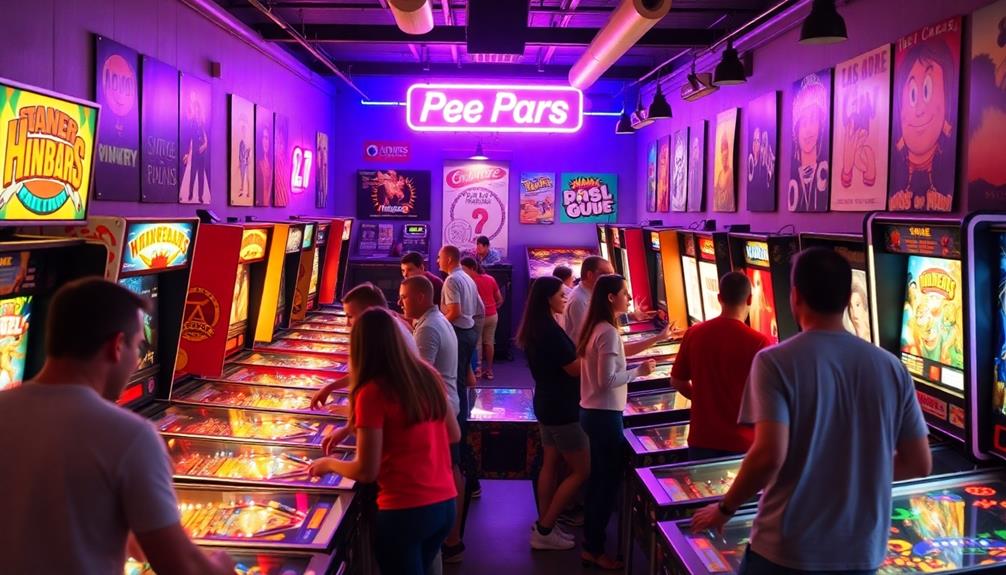
In recent years, a resurgence of pinball machines has captivated both old fans and new players alike, breathing fresh life into this classic pastime. You might notice that the growing interest in pinball is fueled by a nostalgic longing for retro gaming experiences that digital games can't quite replicate. The tactile feel and mechanical gameplay draw you in and create a unique sense of engagement.
This revival mirrors trends seen in other nostalgic pursuits, like the outfits showcased at the recent Met Gala, which celebrate vintage styles.
Online platforms have made it easier than ever for collectors and newcomers to buy, sell, and trade machines, expanding access to this beloved hobby. Additionally, new manufacturers like Jersey Jack Pinball and Spooky Pinball have emerged since the early 2010s, introducing innovative games and themes that attract a diverse audience.
The popularity of pinball has also been enhanced by dedicated pinball arcades and museums, which celebrate the game's history and culture. These spaces provide opportunities for social engagement and community events.
On top of that, competitive pinball tournaments and leagues have seen a rise in participation, showcasing the game's enduring appeal and fostering a vibrant community. The resurgence of pinball is indeed a reflection of its lasting charm and relevance.
Pinball's Cultural Impact and Legacy

Pinball's cultural impact and legacy extend far beyond the flashing lights and clinking sounds of the machines; they reflect a rich history that resonates with players of all ages. Since their rise in the 1930s and 1940s, pinball games have become ingrained in American culture, transforming from simple luck-based pastimes to skill-driven experiences with the introduction of flippers. This transformation echoes the broader theme of how curiosity enhances problem-solving abilities, inviting players to engage with each game in unique ways.
- Competitive tournaments celebrate players' skills and foster community.
- Enthusiast groups preserve the nostalgia and mechanics of classic machines.
- Modern manufacturers innovate, blending retro styles with contemporary technology.
- Events and trade shows showcase the vibrant pinball culture and connect fans.
The cultural significance of pinball is undeniable. Even as video games surged in popularity, pinball experienced a resurgence, driven by a renewed interest in retro gaming.
Today, you'll find a thriving community dedicated to keeping the spirit alive. Whether you're a seasoned player or a newcomer, the charm of pinball machines invites everyone to engage with a legacy that continues to evolve while celebrating its storied past.
You're not just playing a game; you're participating in a cultural phenomenon that's stood the test of time.
Frequently Asked Questions
When Did Pinball Get Popular?
Pinball got popular in the 1930s, especially after Bally's Ballyhoo launched. By the 1950s, thousands filled candy stores and bars. Player-controlled flippers in 1947 made it even more engaging, boosting its appeal considerably.
Why Were Pinball Machines Banned in the 1970S?
While pinball's skillful gameplay thrived, authorities banned it, claiming it encouraged gambling. You'd find machines hidden away, but advocates fought back, proving pinball's strategic nature, leading to a revival and legal acceptance in the 1970s.
When Was the Golden Age of Pinball?
The Golden Age of pinball spanned from the late 1940s to the early 1970s. You'll see this era marked by the introduction of the flipper, transforming gameplay and solidifying pinball's place in entertainment history.
Were Pinball Machines Popular in the 80S?
In the 80s, pinball machines experienced ups and downs. You'd find some popularity, especially after the video game crash, but they struggled against the rise of arcade games. It was a challenging era for pinball enthusiasts.
Conclusion
To sum up, pinball machines have had a fascinating journey, from their early origins to a resurgence today. Did you know that in the 1970s, over 1 million pinball machines were sold each year in the U.S.? That's a demonstration of their widespread appeal! As you explore the rich history and cultural impact of pinball, you'll see how this beloved game continues to captivate players and collectors alike, proving that the thrill of the flipper isn't going anywhere. In fact, the popularity of pinball machines has led to a thriving collector’s market, with vintage machines fetching high prices. If you’re interested in starting a collection, a pinball machine price guide can be a valuable resource for understanding the value of different models and editions. Whether you’re a seasoned player or new to the game, the enduring appeal of pinball machines is undeniable.
